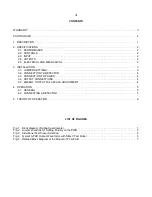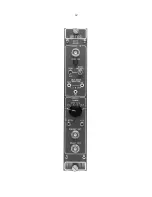
6
5. THEORY OF OPERATION
The complete schematic for the A-576 A-PAD (No.
amplitude for 5, 6, and 7 MeV to the input to the
752500) is included at the back of this manual.
preamplifier. A screwdriver calibration, included on the
Fig. 5 is a block diagram of the electronics.
PWB for factory adjustment of the test pulser circuit,
The detector voltage (TEST/BIAS/OFF) switch on the
front-panel toggle switch is set at BIAS, the test pulser
front panel turns power ON and OFF for the variable
is turned off and does not appear in the output
100-V bias power supply. The power is on to the BIAS
spectrum.
supply in both the TEST and BIAS positions.
The polarity is set by Jumper J1, which is actually
inverted by the preamplifier and are furnished as the
three separate jumpers (see schematic). The indicated
input to the amplifier that includes the first integration
polarity is negative, which is appropriate when an
and differentiation shaping circuits. The amplifier can
ORTEC Ruggedized detector is used. When the
be calibrated by a factory-adjusted trim potentiometer
detector voltage is negative, its output pulses are
on the PWB. The output is a shaped negative pulse
positive. When they pass through the inverting charge-
that can be observed at test point TP3.
sensitive preamplifier, they are negative, and this is
the polarity that is then selected by the pair of jumpers
The pulse at TP3 is furnished into a fixed-level
(J3) on the PWB. If a conventional surface barrier, or
discriminator (U3), and through a diode dc-restorer
ion-implanted, detector is used, all five of these
and integration network. If the amplitude represents
jumpers must be changed to "+" because these
~2.5 MeV or more, the discriminator fires and
detectors, positively biased, generate negative output
generates a positive-shaped pulse that is used to
pulses, which are then inverted, resulting in positive
enable the stretcher. This pulse is also provided as the
pulses at the J3 location in the circuit.
COUNT output signal. The pulse from the second
The 100-V power supply output on the PWB can be
If the stretcher is enabled, the peak amplitude is
tested for both polarity and amplitude at test point
stretched to improve the measurement accuracy of the
TP1, which is identified on the PWB. The variable 0 to
multichannel analyzer, which uses the ENERGY
100 V bias voltage can be measured at the front-panel
output for measurement. If the stretcher is not enabled
test point jack labeled HV.
(because the pulse represents <2.5 MeV), the output
The detector leakage current can be measured across
stretched. The output of the stretcher is a negative
the 1.1-M
6
resistor between front-panel test points HV
pulse that can be monitored at test point TP4 on
and DET, using a 10-M
6
impedance meter. The
the PWB.
voltage (in volts) converts to µA of detector current.
The output of the Bias supply is applied through a
The biased amplifier accepts the stretcher output and
high impedance (totaling 11 M
6
) to the dc connection
the bias level selected by the front-panel ENERGY
between the detector and the preamplifier.
RANGE switch (low end of range). The bias level, or
The output from the charge-sensitive preamplifier can
at 3, 4, 5, or 6 MeV by the ENERGY RANGE switch,
be checked at TP2. The nominal conversion gain is
which can be adjusted by ±10% by the front-panel
45 mV/MeV. The preamplifier gain from the External
screwdriver control, E BIAS.
Pulser input is nominally "
1" at TP2.
The pulser switch (TEST/BIAS/OFF) on the front
bias level from the input pulse amplitude and to
panel turns power on and off for the test pulser. The
amplify the excess amplitude by a factor of 10 on the
test pulser can be set to furnish the equivalent pulse
3
&
5, 4
&
6, 5
&
7, and 6
&
8 MeV ranges, and by a factor
should not be changed by the customer. When the
Pulses from the detector and/or the test pulser are
integration shaping circuit is furnished to the stretcher.
is passed to the biased amplifier without being
lower level, accepted into the bias amplifier can be set
The function of the biased amplifier is to subtract the
Содержание ORTEC A-576 A-PAD
Страница 4: ...iv ...





























